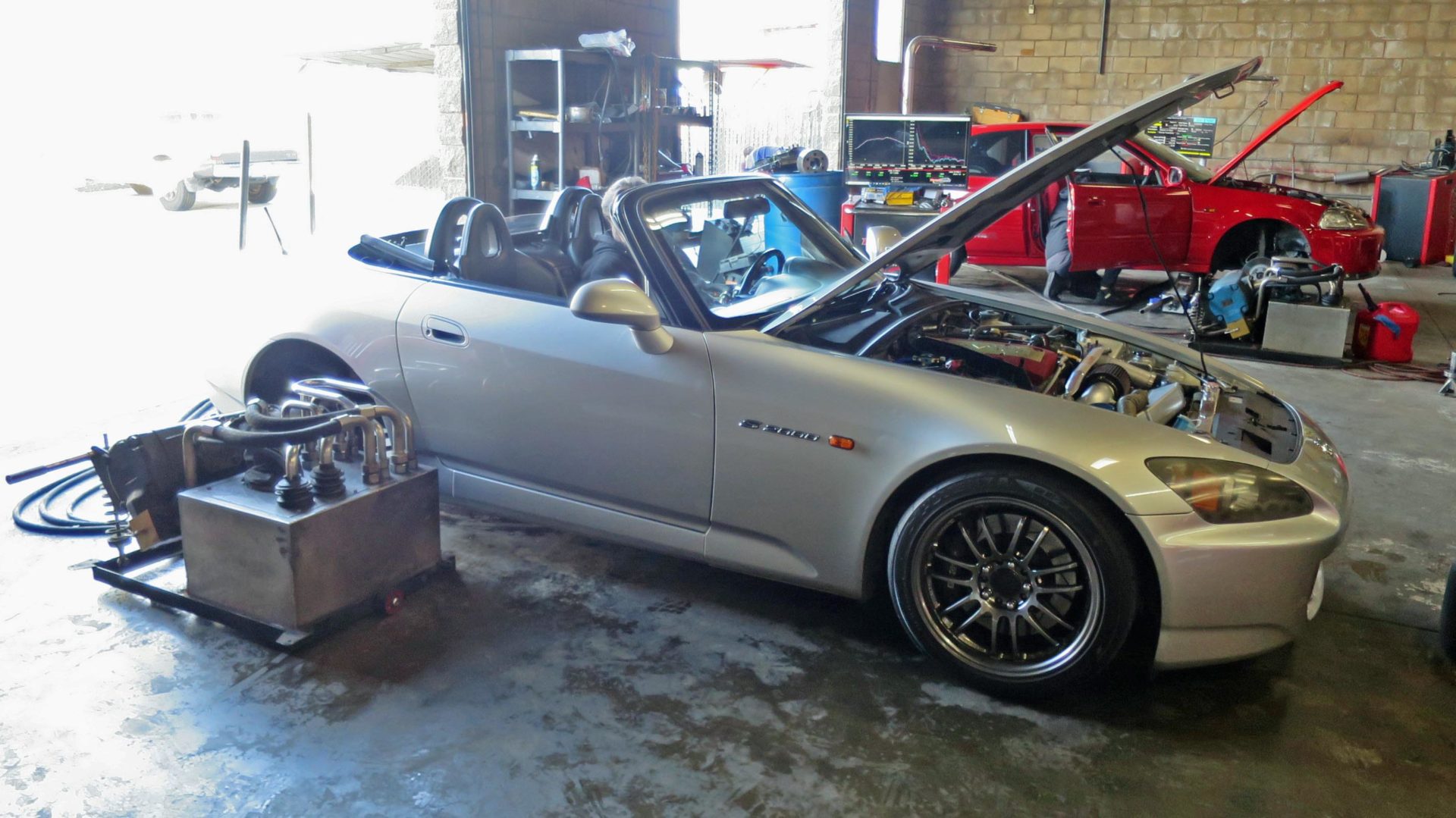 My mistake did prompt me to add an AEM coolant temperature gauge to monitor the intercooler coolant temperature. The sensor is screwed into an Autometer adapter with ¾” hose barbs. This new piece of data has proved to be more interesting and useful than the wideband.
My mistake did prompt me to add an AEM coolant temperature gauge to monitor the intercooler coolant temperature. The sensor is screwed into an Autometer adapter with ¾” hose barbs. This new piece of data has proved to be more interesting and useful than the wideband.
 I plumbed in the sensor at the coolant pump outlet. For long-term durability and robustness, I recommend using constant tension clamps where possible on coolant lines.
I plumbed in the sensor at the coolant pump outlet. For long-term durability and robustness, I recommend using constant tension clamps where possible on coolant lines.
 The AEM coolant temperature sensor wire runs parallel to the coolant pump power cable. I was able to tidy up the wiring going through the bulkhead under the clutch master cylinder.
The AEM coolant temperature sensor wire runs parallel to the coolant pump power cable. I was able to tidy up the wiring going through the bulkhead under the clutch master cylinder.
 When I had Bell Intercoolers fab up the intercooler for me, I wasn’t sure how I’d end up mounting the unit. Therefore, there’s no bleed port on the intercooler. To help get the air out of the system, I jacked up the side of the car and used a 12V jumper pack to run the pump. I pulled vacuum on it too with the trusty Mityvac hand vacuum pump. After all that, it still took three buddies ragging on the car the next day to get all the air out of the system after which I topped off the reservoir.
When I had Bell Intercoolers fab up the intercooler for me, I wasn’t sure how I’d end up mounting the unit. Therefore, there’s no bleed port on the intercooler. To help get the air out of the system, I jacked up the side of the car and used a 12V jumper pack to run the pump. I pulled vacuum on it too with the trusty Mityvac hand vacuum pump. After all that, it still took three buddies ragging on the car the next day to get all the air out of the system after which I topped off the reservoir.
 I placed the coolant temperature gauge a bit further back than previously which blocks a bit more of the tachometer. I found that when the gauge was placed more off to the side, which also resulted in it being closer to me, my eyes would have to shift focus going between the gauge and the dash. That split second of time for my eyes to refocus was annoying, so I pushed the gauge as far back as I could while still having access to the buttons behind. I can use the ARK Design MFD2 to show engine rpm for those times I want to see where it’s spinning below 3.5k RPMs.
I placed the coolant temperature gauge a bit further back than previously which blocks a bit more of the tachometer. I found that when the gauge was placed more off to the side, which also resulted in it being closer to me, my eyes would have to shift focus going between the gauge and the dash. That split second of time for my eyes to refocus was annoying, so I pushed the gauge as far back as I could while still having access to the buttons behind. I can use the ARK Design MFD2 to show engine rpm for those times I want to see where it’s spinning below 3.5k RPMs.




16 comments
Epic build! Always love your updates. Your attention to detail and penchant for data is an inspiration. Looking forward to hearing how the “quickspool” effects things.
On a side note, I must say that I would love to see this thing with a full OE style valved* exhaust. Big pipes and cats, but giant mufflers and electronically controlled cutout! It would cost a human soul to do right but man that would just be the cherry on top of an already incredible build!
I was confused for a bit on the boost curve shape until the mention of constant duty cycle came up – I may be spoiled by having worked with stuff natively designed for turbos and forgot that PID isn’t a given. Interesting results and gratifying even from here to see what it can do, I imagine it’s far moreso on your side of the screen.
Flat torque from 3500 rpm to 8000 rpm in an f20c proves your diligence in designing the turbo system was worth the effort. great read!!!
What I’d really like to see is this with G30-660 or 770, 0.83 A/R, on a track setup with wastegate dump and bigger exhaust. it should really flow well on the top-end.
The G30 series makes me go sploosh. Once I’m done with my current turbo (Boostlab) I’ll look at the g series.
Agreed but for a street car, making that much torque that low AND being quiet is nice.
Can’t wait to read about it!!!
With the extra manifold, maybe consider consulting with Artec Performance and see if they could work with the design? I’d love to see your manifold become more readily available (or might have to shoot you an email about it)
Incredible build otherwise!
I could always sell the design I guess! The car has been a big long science project and it’s been a lot of fun.
It’s been a blast to watch it all come together I’ve been following it for years! Hoping to see an update with E85 added in one day
I would love to see the design sold and other people trying different setups with it!
Thought about testing the 0.92 A/R housing on the current setup and switching to a less restrictive exhaust ? That combined with some quickspool should wake up both the mid-range and top end. I’ve run up to 90% quickspool duty with larger turbos using the Honda-based ECU code. With this smaller turbo, you probably don’t need that much though. Try using quickspool pressure equal to wastegate pressure if targetting more than WG pressure or 1-2 psi under wastegate to prevent boost spikes.
Some tuners map in quickspool in the WG duty table and don’t use the pre-set Hondata feature. This allows you to tailor quickspool to different target pressures (boost per gear for example)
I’d go to G30-660 in 0.83AR before the G25-660 with 0.92. That G30 config would spool faster and make more power I think. I’m happy with the exhaust volume noise as it is, so no changing it. I’ve had some time to adjust the boost by gear and the settings for the quick boost. I’ll update in the next article but your recommendation of targeting around WG pressure is accurate. If you look at the screen shot of the boost settings in this article, you’ll see the targets are higher than achievable in the lower rpm range which is the alternative strategy you mentioned. I’m not sure if I like the quick spool yet, I need to get out in the canyons and see what the throttle/boost/torque modulation is like in the twisties.
Are you just set on keeping the stock axle back exhaust section or would you consider making a nice system and perhaps including a resonator or two to keep things quiet and streetable without producing so much back pressure?
I’m set on it to keep the stock/stealth appearance. I’ve been driving it a couple times a week and I honestly leave it on low boost/wastegate most of the time as most of my driving is on surface streets. I can still give it full throttle without spinning in second gear once the tires are warmed up.
Hello Khiem, i do have some questions related with an article you did back in 2012. Can you kindly email me?
Thx,
Rafael,
Spain
Awesome project. LHT Performance did a similar build and they did a custom twin exit exhaust where side is opened via vacuum/boost for sufficient flow under larger boost settings, yet still quiet like stock-ish under normal throttle low speed etc. Check it out on youtube. Can’t wait for the next iteration!
Yup, I catch their videos here and there. I’m impressed they got the internally gated turbo to fit, though they did have to compromise on the manifold design a bit. I figure a freer flowing rear exhaust section with larger diameter pipes and straight-thru mufflers would free up 20-30hp on this setup. And still be pretty quiet.